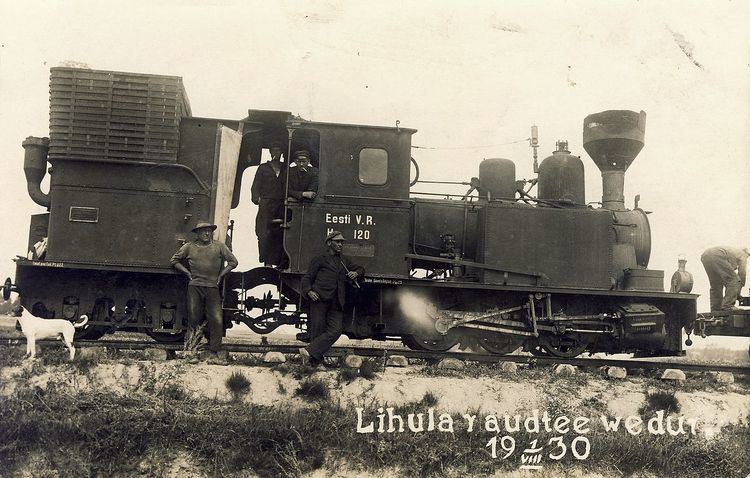 | ||
The history of rail transport in Estonia starts in 1870 when a line was opened connecting Paldiski, Tallinn, Tapa and Narva; the line extending all the way to St. Petersburg in Russia.
Contents
Beginnings of Estonian railways in Imperial Russia
The first railway line to be built in Estonia was the Paldiski – Tallinn – Narva – Gatchina line constructed in 1870; Baltic German nobility provided the impetus for the construction of the line, though because of the Russian influence the line was built to 1524mm (5 ft) gauge to connect with the line from St. Petersburg to Warsaw . The construction project was controlled by the Russian Ministry of Roads. The port of Paldiski was chosen because its southerly position made it ice free all the year round. Soon after both Paldiski and Tallinn experienced an upswing in trade, notably exports of grain.
In 1877 another line was complete, connecting Tapa and Tartu; later extended to Valga in 1887, which brought a connection to Latvia via the Pskov – Valga – Riga line also being constructed at the same time.
Additionally a network of narrow gauge railways (750mm) were being built in Estonia, the first connecting Valga and Pärnu in 1896, then Mõisaküla to Viljandi (1897), later extended via Paide to Tallinn in 1901.
Railways in the republic of Estonia (1918–1940)
At the end of World War I and the collapse of the Russian Empire, the country was occupied by Germany and a puppet government installed. This subsequently collapsed with German defeat in World War I and Estonia became a republic in 1918. Finally, after the expulsion of invading Soviet forces during the Estonian War of Independence, Estonia became a recognised independent republic in 1920.
At the time of its creation, the railways had 648 km of broad gauge and 187 km of narrow gauge track and 90 broad gauge locomotives, 72 narrow gauge locomotives plus rolling stock.
Thus the railways of Estonia became known as Eesti Raudtee (EVR), formed from the Looderaudtee (North-Western Railway), Esimese Juurdeveoteede Selts (First Association of Approach Tracks) as well as military and other railway lines. One consequence of the new independence was that the railway architecture did not have to follow the imperial style set out in St. Petersburg - architectural trends followed those in other parts of the world - with neo-baroque styles with romantic-vernacular elements giving way to functionalist architecture in the 1930s.
In 1931, a 1524mm gauge line opened between Tartu and Petseri.
By 1940, the EVR had 772 km of broad gauge and 675 km of narrow gauge track.
Railways in the Estonian SSR (1940–1991)
In June 1940, Estonia was invaded by the Soviet Union becoming the Estonian SSR; EVR became part of the Russian rail system again, the country was invaded by Nazi Germany and occupied by German forces between 1941 and 1944. During German occupation the network was converted to standard (1435mm) gauge, and rolling stock from Germany used. After the end of the Second World War, Estonia was once again part of the Soviet Union and the railways were run as part of the Soviet Union's rail network; the track was converted back to broad gauge.
Much infrastructure was destroyed during the war and as a consequence many station buildings are in the neo-classicist style (see Stalinist architecture) having been rebuilt in the post war years.
Soviet planning placed the emphasis on broad gauge track and much freight formerly transported on narrow gauge lines was moved by road, lines were also converted to broad gauge. Starting in 1957, steam locomotives began to be replaced by diesel locomotives. Though the narrow gauge lines were closed the broad gauge sections prospered: in 1945 passenger numbers were 12.2 million, freight volumes 4.3million tonnes. The railway network became part of the Pribaltiiskaya section
New broad gauge lines were built in the 1960s replacing some of the narrow gauge lines while some others were closed. The last public narrow gauge line closed in June 1973.
In 1980, 36.5 million passengers were being carried The construction of a new port at Muuga (north-east of Tallinn) began in 1986, as part of that project new the railway link between Tallinn and Tapa was updated. In 1990, 30.1 million tonnes of freight carried; the new port contributing significantly to this figure.
Railways in Estonia (1991–)
Estonia began moving towards a second independence in 1988, and by 1991 was recognised as an independent state. On 1 January 1992 Eesti Raudtee (EVR) came into being as a state owned company.
Privatisation
As part of a privatisation plan EVR became Estonian Railways Ltd. in 1997 with the state controlling 100% of the shares.
Three organisations were formed in 1997-1998 for future privatisation:
In 2001 a 66% stake in EVR was acquired for $58 million by Baltic Rail Services (BRS). Whilst under private ownership many second hand American built GE locomotives were introduced. In 2007 EVR was re-nationalised and the company became 100% state owned again.
Future
In 2004 Estonia joined the European union - for rail transport this has clear consequences, an EU directive of 1991 (EU Directive 91/440) suggested the separation of railway operation structure into track, and train operators with the intention of encouraging or allowing new railway operators to be able to run trains on other companies tracks ("de-monopolisation or railways"), a related directive extends the encouragement of competition to inter-state railway operations. For the railways of Estonia this means the possibility of new companies operating on Estonian railways such as the Haapsalu Raudtee which sees restarting passenger operations on the Haapsalu line as a possible option, and increased competition from other railways, such as the Russian company SeverStal.
